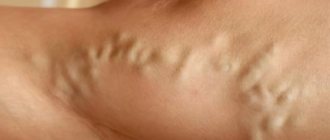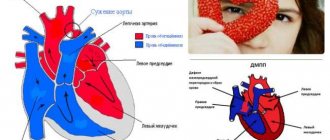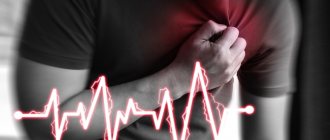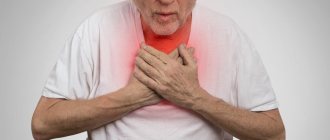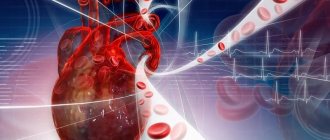Hydropericardium refers to the accumulation of transudate (non-inflammatory fluid) in the pericardial cavity. Normally, between the layers of the pericardium there is a small amount of lubricant (about 30 ml), which is necessary for the normal functioning of the heart. An increase in the volume of transudate is usually due to increased permeability of the vessels of the pericardial sac in the decompensated course of chronic diseases, or difficulty in its reabsorption, which is caused by venous stagnation.
- Causes
- Symptoms and possible complications
- Diagnostics
- Treatment, prognosis and prevention
What is pericarditis
Pericarditis is an inflammation of the pericardium, the thin, two-layered sac that surrounds the heart.
There is a small amount of liquid between the layers to prevent friction during beating. When the layers become inflamed, this can lead to disruption of the full functioning of the heart, the formation of adhesions in the cavity, fluid accumulation and chest pain. The pericardium also helps keep the heart inside the chest. Pericarditis usually occurs suddenly and lasts from several days to several weeks.
Anyone can get pericarditis. In most cases, it goes away on its own. However, 15 to 30% of people get it more than once—this is called recurrent pericarditis.
There are several forms of pericarditis:
- acute - it can occur on its own or as a symptom of an underlying disease;
- recurrent - can be periodic or constant, the first recurrence usually occurs within 18 - 20 months from the initial illness;
- chronic - in this case, relapse occurs immediately after treatment;
- delayed (Dressler syndrome) - it develops several weeks after heart surgery or a heart attack;
- constrictive - the pericardium scars or sticks to the heart so the heart muscle cannot expand (this form is rare and can develop in people with chronic pericarditis or after heart surgery);
- effusion-constrictive pericarditis - in this case, effusion (fluid) accumulates in the pericardium and a narrowing of the heart occurs.
One third of people with pericardial effusion develop cardiac tamponade, which requires emergency medical attention.
Varieties
There are different types of pulmonary edema:
- fulminant. It develops extremely quickly, in a few minutes - the outcome in this case is only fatal;
- spicy. Symptoms increase over four hours and the risk of death is very high. Such swelling often occurs with heart attack, suffocation, and traumatic brain injury;
- subacute. The development of symptoms alternates between active and quieter stages. Occurs in liver failure;
- protracted. It can develop within twelve hours, even several days, and not have a clear manifestation. It manifests itself in heart failure, as well as chronic lung diseases.
Obviously, each option requires different actions. If the patient can still be saved, speed of response will be a key factor.
Causes of pericarditis in adults
The cause of most pericarditis is unknown, but 80 to 90% of cases are thought to be associated with infections (viruses, bacteria, fungi, and parasites).
In addition, pericarditis can be caused by:
- cardiovascular problems (previous heart attack or surgery);
- injuries;
- radiation therapy;
- autoimmune diseases such as lupus;
- some medications, which is rare;
- metabolic disorders such as gout;
- renal failure;
- some genetic diseases, such as familial Mediterranean fever;
- cancer;
- some medications.
How to prevent pulmonary embolism?
To avoid pulmonary embolism, it is necessary to prevent and promptly treat chronic diseases. One of the causes of venous thrombosis is varicose veins. Any person who suspects he has this disease should visit a phlebologist and have the venous system of the lower extremities diagnosed. After diagnosis, you need to follow the doctor's recommendations. Also, patients planning major surgery should be assessed for the risk of deep vein thrombosis, and people at high risk of DVT may require prophylactic doses of anticoagulants before and after surgery.
Symptoms of pericarditis in adults
Pericarditis can feel like a heart attack with sudden, sharp or stabbing pain in the chest.
The pain may be in the middle or left part of the chest, behind the breastbone, and may spread to the shoulders, neck, arms or jaw. Other symptoms may include:
- temperature;
- dry cough;
- weakness or fatigue;
- difficulty breathing, especially when lying down;
- cardiopalmus;
- swelling of the feet, legs and ankles.
Symptoms that occur may worsen if the patient lies down, takes deep breaths, coughs, eats, or drinks.
But if he sits leaning forward, it gets better. If the cause of pericarditis is a bacterial infection, the patient may have fever, chills, and a higher than normal white blood cell count. If the cause is viral, there may be flu-like symptoms or stomach upset.
In any case, if chest pain appears (it happens in 85 - 90% of cases), you should immediately call an ambulance.
Therapeutic measures
Treatment for diagnosing fluid in the organ cavity includes two directions: relief of negative symptoms and treatment of the underlying pathology, as well as prevention of complications.
The following methods are used:
- To reduce the amount of sweated exudate, diuretics (Furosemide, Veroshpiron) are prescribed.
Non-steroidal anti-inflammatory drugs are used as drugs to relieve the symptoms of inflammation. For example, Ibuprofen. In severe, protracted cases, Colchicine is used together with it. These drugs are taken simultaneously with probiotics and medications that normalize kidney and liver function (Hilak-forte, Essentiale).- If the causative agent is an infection, antibiotics (Ceftriaxone, Amoxicillin) or antiviral drugs Groprinosin, Interferon are used). If necessary, add antiparasitic and antifungal agents (Nystatin, Pyrantel).
- If the cause is autoimmune pathologies, glucocorticosteroids (Prednisolone, Dexamethasone) and cytostatics (Cisplatin) are used. Prednisolone in small doses is indicated only for relieving asthma attacks, because it is addictive.
- If there is a threat of tamponade, a suspected purulent process, or the absence of resorption of the exudate, a puncture of the pericardial cavity is made in order to remove the fluid mechanically. This procedure is also used to determine the etiology of the disorder.
- In more complex situations, pericardiotomy is used. This is a surgical intervention whose purpose is to remove part of the pathological pericardium.
Diagnostics
Other tests used for diagnosis include:
- a chest x-ray, which shows the shape of the heart and possible excess fluid;
- an electrocardiogram (ECG) to check your heart rhythm and see if the voltage signal is decreasing due to excess fluid;
- an echocardiogram, which will also show the shape, size of the heart and fluid accumulation;
- MRI;
- computed tomography, which provides a detailed image of the heart and pericardium;
- right heart catheterization, which will provide information about the pressure in the heart;
- blood tests to look for inflammatory markers that indicate pericarditis.
Modern methods of treatment
Treatment for pericarditis will depend on its underlying cause.
If it is a bacterial infection, antibiotics may be prescribed. In most cases, according to the American Heart Association, pericarditis is mild and goes away on its own - you just need to rest. But the doctor may prescribe non-steroidal anti-inflammatory drugs (Ibuprofen, Aspirin). If there are other medical risks, the patient may be hospitalized. In this case, therapy will be aimed at reducing pain, inflammation and minimizing the risk of relapse. As a rule, Colchicine is prescribed in this case.
Corticosteroids are also effective in reducing the symptoms of pericarditis, however, studies have shown that early use of these drugs may have an increased risk of recurrence of the disease and should be avoided except in extreme cases where the disease is refractory to conventional treatment.
Surgery may be considered for recurrent pericarditis that does not respond to other treatments, in which case the pericardium is removed.
Frequently asked patient questions about pulmonary embolism (PE)
What are the symptoms of pulmonary embolism?
The main symptoms to suspect pulmonary embolism are cough, shortness of breath, chest pain and hemoptysis.
How to avoid pulmonary embolism?
In order to prevent the development of pulmonary embolism, it is necessary to prevent venous thrombosis: promptly treat varicose veins and other vein pathologies, avoid prolonged immobilization for various diseases and surgical treatment, use anticoagulants in case of increased risks of thrombosis.
Who is more likely to develop pulmonary embolism?
Pulmonary embolism, as a rule, affects patients with severe cardiac and pulmonary pathology, cancer patients, and patients in various surgical hospitals after long-term surgical interventions.
What should you do if you suspect pulmonary embolism?
At the slightest suspicion of pulmonary embolism, you must call an ambulance. Before the arrival of medical personnel, the patient must be laid on a flat surface and ensure free access of air.
Popular questions and answers
We asked cardiologist Stanislav Snikhovsky to answer questions about pericarditis.
What complications can occur with pericarditis?
In general, pericarditis is considered a disease with a favorable outcome, since timely, qualified care leads to complete recovery in most patients. In rare cases, with severe disease, the following complications may occur:
- thickening or sticking together of the pericardial layers (external and internal), which leads to difficulty in the functioning of the heart and the development of heart failure;
- cardiac tamponade (accumulation of a large amount of fluid between the layers of the pericardium), which also leads to difficulty in the functioning of the heart, the development of heart failure and possible cardiac arrest;
- the formation of fistulas (holes) of the internal mammary artery - this is possible only with purulent pericarditis and is a rare complication.
After pericarditis, cardiac conduction disturbances may occur for a long time. They manifest themselves as periodic attacks of arrhythmia (especially during physical activity).
When to call a doctor at home if you have pericarditis?
Pericarditis usually develops gradually.
Therefore, if major complaints and symptoms occur, you must consult a doctor for diagnosis. Most often, patients complain of shortness of breath (at rest or with light physical exertion), pain in the heart area, palpitations, and general weakness.
Is it possible to cure pericarditis with folk remedies?
There are many treatment options for pericarditis.
As a rule, they depend on the cause of pericarditis (treatment of the disease that caused pericarditis leads to the disappearance of symptoms of pericarditis, up to recovery). Only a doctor can prescribe treatment for pericarditis after a complete examination and determination of the cause of the disease. Folk remedies in the treatment of pericarditis are used as additional therapy and only in the treatment of dry (fibrinous) pericarditis. Among them:
- decoction of young pine needles;
- a collection of hawthorn, calendula, linden flowers and dill;
- infusion of birch catkins;
- collection from the root of valerian officinalis, yarrow and lemon balm leaves.
Published on the portal kp.ru
Preventing heart disease during coronavirus
The health and life expectancy of a person directly depends on the state of the cardiovascular system. To prevent heart and vascular diseases, you will need a set of measures related to a responsible attitude towards your body.
Basic preventive measures:
- undergo preventive examinations at the clinic in a timely manner;
- adhere to a balanced diet, consume more fruits and vegetables, reduce the amount of animal fats;
- maintain water and drinking regime;
- pay attention to physical activity;
- spend more time in the fresh air;
- stop drinking alcohol, smoking, and taking drugs; avoid stressful situations;
- control pressure in arterial vessels;
- If symptoms of cardiac or vascular dysfunction develop, make a timely appointment with a cardiologist.





